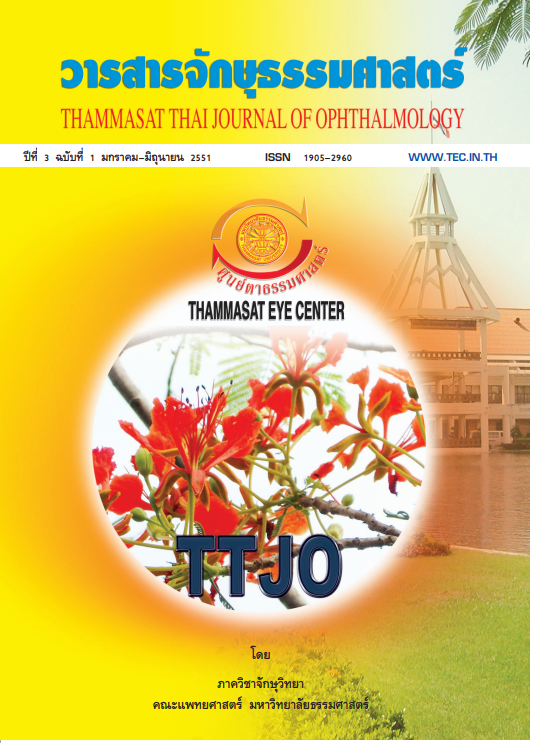ภาวะสายตาผิดปกติในเด็กนักเรียนชั้นประถมศึกษาของโรงเรียนธรรมศาสตร์
Main Article Content
Abstract
วัตถุประสงค์ : เพื่อศึกษาหาอัตราความชุก (Preva-lence) ของภาวะสายตาผิดปกติ (refractive error) ในเด็กนักเรียนชั้นประถมศึกษาของโรงเรียนธรรมศาสตร์คลองหลวงวิทยาคม จังหวัด ปทุมธานี
วิธีการศึกษา : เป็นการศึกษาในเด็กนักเรียนชั้นประถมศึกษาปีที่ 1 ถึงประถมศึกษาปีที่ 4 ที่มีอายุตั้งแต่ 8-10 ปี โดยการตรวจวัดค่าสายตา (refraction) ทั้งก่อนและหลังการหยอดยา 1 % cycolpentolate, การตรวจความผิดปกติทางตา และสอบถามประวัติการได้รับการรักษาเกี่ยวกับภาวะสายตาผิดปกติ
ผลการ ศึกษา : เด็กนักเรียนที่เข้ารับการตรวจจำนวน 120 คน (เด็กชาย 51 คน และเด็กหญิง 69 คน) อายุระหว่าง 8-10 ปี (เฉลี่ย 9.6 ปี) ตรวจพบมีภาวะค่าสายตาผิดปกติ เมื่อวัดสายตาหลังการหยอดตา 1% cyclopentolate (cycloplegic refraction) จำนวน 39 คน (32.5%) แบ่งเป็นภาวะสายตาสั้น (มีค่าสายตามากกว่าหรือเท่ากับ -0.5 D) จำนวน 20 คน (16.7%),ภาวะสายตายาม (มีค่าสายตามากกว่าหรือเท่ากับ +2.0 D) จำนวน 4 คน (3.3%) และมีภาวะสายตาเอียง (มีค่า cylinder มากกว่าหรือเท่ากับ -0.75 D) จำนวน 27 คน (22.5%)
สรุป : ภาวะสายตาผิดปกติ มีอัตราความชุกสูงในเด็กนักเรียนชั้นประถมศึกษา โดยปัญหาส่วนใหญ่คือภาวะสายตาเอียงและสายตาสั้น ซึ่งมีผลต่อความสามารถในการเรียนรู้ของเด็ก นับเป็นปัญหาสาธารณสุขที่สำคัญ จึงจำเป็นต้องมีการตรวจคัดกรองภาวะสายตาผิดปกติในเด็กวัยประถมศึกษา เพื่อในการดูแลรักาษาที่เหมาะสมต่อไป
Refractive Error of Primary-school Children at
Thammasat School
Abstract
Objective : To assess the prevalence of refractive error in primary school-age children at Thammasat school, Pathumtani
Method : Random selection a sample of children from primary-school grade 1 to grade 4 (8 to 10 years of age). The examination include retinoscopy with autorefraction before and after cycloplegia (cycloplegic refraction) and history of previous refractive error management
Result : A total of 120 students (51 boys and 69 girls) were involved in study. Their age ranged from 8 to 10 years (average 9.6 years old). The prevalence of refractive error (cycloplegic refraction) was 32.5% (39 students). Myopia (at least -0.50 D)
in one or both eyes was present in 16.7% (20 students). Hyperopia (+2.00 D or more) in at least one eye was present in 3.3% (4 students). Astigmatism (at least -0.75 D) in one or both eyes was present in 22.5% (27 students)
Conclusion : Refractive error, associated primarily with astigmatism and myopia are major causes
in primary-school children. Reduced vision because of uncorrected refractive error is a major public health problem. Vision screening is needed to eliminate cause of vision
impairment.
Article Details
References
คู่มือการคัดกรองสายตาเด็กนักเรียน สำนักพัฒนาระบบบริการสุขภาพ กรมสนับสนุนบริการสุขภาพ กระทรวงสาธารณสุข ธันวาคม 2547
Lin LL, Shih YF, Hsiao CK, Chen CJ. Prevalence
of myopia in Taiwanese schoolchildren.
Ann Acad Med Singapore. 2004 Jan;33(1):
-33.
Saw SM, Tong L, Chua WH. Incidence and
progression of myopia in Singaporean school
children. Invest Ophthalmol Vis Sci. 2005
Jan;46(1):51-7.
Nagrel AD, Maul E, Pokharel GP, et al.
Refractive Error Study in Children: Sampling
and measurement methods for a Multi-Country
Survey. Am J Ophthalmol 2000;129:
-6.
Kenneth W. Wright, Peter H. Spiegel.
Pediatric Ophthalmology and Strabismus. 2nd
ed. New York. Pringer-Verlag; 2003.
Goh PP, Pokharel GP, Abqariyah Y, et al.
Refractive error and visual impairment in
school-age children in Gombak District,
Malaysia. Ophthalmology 2005;112(4):678-85.
Murthy GV, Gupta SK, Ellwin LB, et al.
Refractive error in children in an urban
population in New Delhi. Invest Ophthalmol
Vis Sci 2002;43(3):623-31.
Zhao J, Pan X, Sui R, et al. Refractive Error
Study in children: results from Shunyi District,
China. Am J Ophthalmol 2000;129(4):427-35.
Maul E, Barroso S, Munoz SR, et al. Refrective
Error Study in children: results from la Florida,
Chile. Am J Ophthalmol 2000;129(4):525-7.
Dandona R, Dandona L, Srinivas M, et al.
Refractive error in children in a rural population
in India. Invest Ophthalmol Vis Sci
;43(3):615-22.
Fotouhi A, Hashemi H, Khabazkhoob M, et
al. The prevalence of refractive errors among
schoolchildren in Dezful, Iran. Br J Ophthalmol
;91(3):287-92


